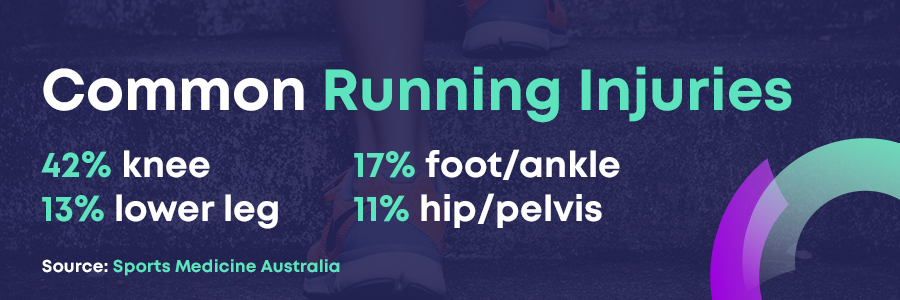Injuries from running are becoming extremely common with more and more people non-runners taking to the streets to start running as a form of exercise and social activity. With this we have seen an increase in minor injuries that have come from running.
Your body is designed to handle stress in small doses but if you consider that when you are running quickly, every time your foot touches the ground your leg absorbs up to three times your body weight. This is just for a single step, think about how many steps you take when you are out for a run – the pressure is bound to build up if proper preventative measures are not made to preserve the body’s natural capabilities.

There are 2 major types of running injuries. The first is an acute injury that occurs after a single event, such as tripping over on your run or twisting your ankle. Unfortunately there isn’t much you can do about these, they are freak accidents and something that may happen.
The second type is a repetitive injury and this is what we are going to talk about. Repetitive injuries, like the name implies, occur slowly over time as a result of performing the same motion. A repetitive injury can be avoided but first we want to talk about what can cause a running injury.
What causes running injuries?
A previous injury: Naturally, a previous injury makes the affected body part more vulnerable to a future injury. Specific treatments, exercises and time required to rehabilitate will ensure your injuries make a full recovery.
Overload: Drastic changes in distance or intensity, such as cross-country running can be too much on the body to cope with in one session. The most effective exercise to prepare runners for added pressure is single-leg squats and deep-core activation.
Undernourishment: If you are not fueling your body with the proper amount of protein, nutrients and hydration it needs to function at optimal performance, your body will burn out. Always ensure you are adequately hydrated, and you have ingested enough protein for muscle repair.
So what can you do to prevent running injuries?
Our top tips for running injury prevention
Quality running shoes are a must
The more you run, the more you will realise the importance of investing in a good quality running shoe. Plantar fasciitis is one of the most common running injuries and can come from not wearing supportive running shoes. A well-fitted pair of shoes will reinforce support, helping your body in the long run.
Stretch, stretch and stretch
This isn’t just for running but stretching can help prevent injuries in all sports. Having a stretching program at the foundation of your training is vital. But don’t over stretch as this can actually cause injuries. If you are new to running check out our stretching guide for new runners with a really simple but effective warm and stretching routine you can do.
Proper running technique
Shin splints or joint pain is a result of the heel landing first with each step – also known as heel striking. Research has shown that runners landing with their forefeet first are likely to have fewer knee injuries. Practice taking steps landing midfoot first with your foot directly underneath your body to create a healthier running style. You might have to seek help from a running club, so find your local running club here and ask them for advice.
Keep a strong core
Having a strong core helps maintain a good posture while running, which prevents post-run lower backache. Adding core exercises to your training will give you the support you need to maintain a good posture while running. Another good tip is to keep your shoulders relaxed while you run, you can do this by lifting your shoulders to your ears and letting them drop in a comfortable position.
How to prevent running injuries with healthy habits
Like we have mentioned before, you need a good warm up routine. Get into the habit of stretching and warming up before every run and then doing a good cool down after.
Set up a running program for yourself and having goals for each run will not only keep you motivated but will ensure you’re not overworking the same muscles.
Another effective running injury prevention tip is to check in with your body during downtime. By sitting at the bottom of a squat for a few minutes, your hips, ankles and knees will be under a lot of pressure, which will allow you to see which areas need attention before your next run.
Incorporating these healthy habits into your lifestyle will not only allow you to progress in your running capabilities, but it will also dramatically decrease the risk of leg injuries from running.
We know, the whole point is to push your limits – and you can, but the key to long-term running is a gradual approach.





